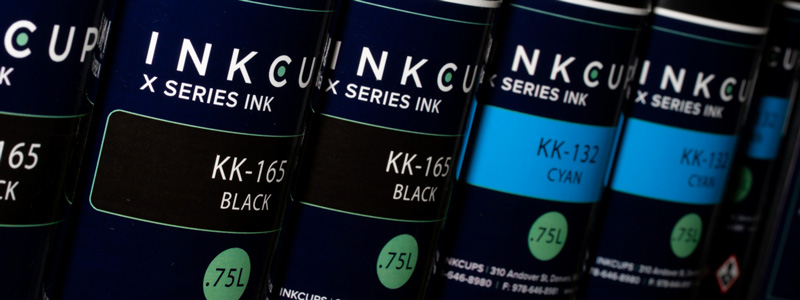- Equipment
- Inks & Supplies
- Services
- Applications
- Tagless
- Resources
- About Us
- Contact Us

UV inkjet ink is available in a wide variety of series. Each ink series is formulated for a particular substrate. So, how can we tell which UV inkjet ink is best for my product?
UV inkjet ink is used in digital printing equipment, also known as UV printers. These digital printers are capable of printing full-color images directly onto three-dimensional objects. Depending on the digital printer or print head, in particular, only a certain ink will be right for the machine. Always consult the equipment manufacturer for recommendations on UV ink.
The ink is UV curable, meaning it cures under ultraviolet light. The ink is jetted onto the surface of a part and then exposed to UV light to “cure” or harden the ink onto the substrate. Curing the ink is essential to increase adhesion and abrasion resistance. Some UV inkjet ink is curable under an LED light. LED is a low-temperature solution for curing UV ink, just be sure your ink is UV LED ink. LED curing is important for heat-sensitive parts such as electronics.
UV inkjet ink typically is available in cyan, magenta, yellow, and black. The combination of these colors can form millions of colors. In addition to CMYK, white is often added to UV inks. White is important for printing on dark substrates and for making other colors pop by laying white underneath a color. For those looking to match nearly any color and offer realistic skin-tines and smoother gradients, a light cyan and light magenta are added to the CMYKW mix to offer more color options.
The goal of choosing the right UV inkjet ink is adhesion. The UV ink must stick to the substrate without easily coming off. To get optimal adhesion, you have to know your substrate. Just because your substrate is made of glass or plastic, it doesn’t mean there is only one type of UV ink that will adhere to it. The chemical composition of a substrate is complex. Plastic, for example, has seven different varieties. Some such plastics are flexible and require a much different UV inkjet ink than harder plastics. Plastic such as Tritan is a difficult substrate to print because it often requires pretreatment for better adhesion.
It is important to know what kind of substrate you are dealing with before finding the right UV ink. What classification is your plastic? What type of glass do you have? Learn how to read the small numbers on the bottom of your substrates. If the substrate doesn’t contain any information, contact the supplier to find out.
Sometimes its not clear what type of substrate you have. Contact Inkcups and set-up no-cost adhesion testing to find the right ink for your part. Inkjet sample technicians will analyze the substrate to determine what ink and pre-treatment methods are necessary. The substrate will be printed with the UV ink of choice and then the adhesion is tested. Following ASTM standards in adhesion testing, our technicians will scratch, tape, and crosshatch the print to ensure optimal adhesion.
Overall, finding the right UV inkjet ink is important. Start with the substrate. Know what you’re dealing with. Test the ink adhesion. Adhesion and quality should be a top priority. Contact us if you have any questions about UV inkjet ink or adhesion.
Notifications
Add Your Comment